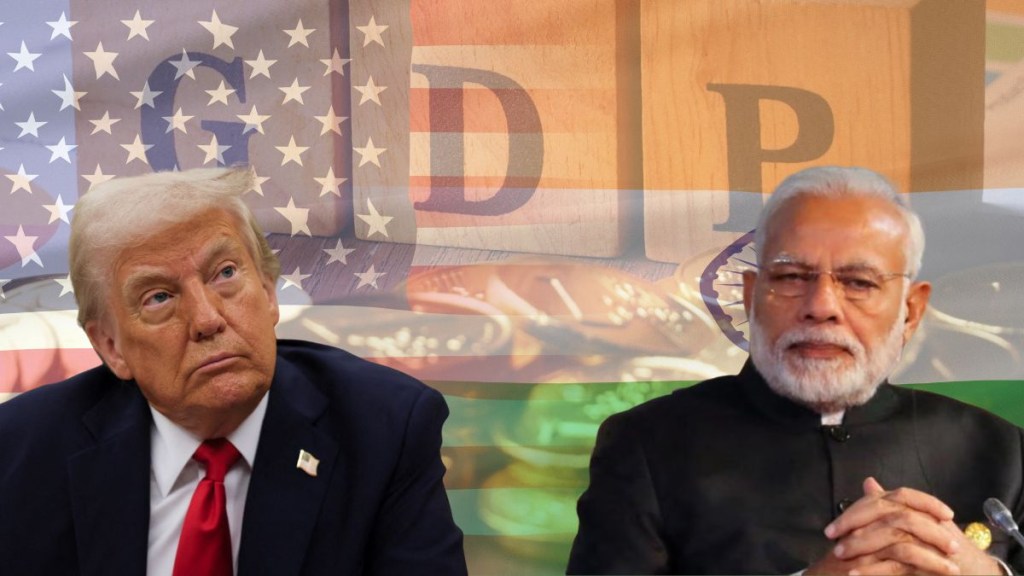India’s growth outlook is faced with fresh headwinds after the US sharply increased tariffs on Indian exports to 50 per cent. Morgan Stanley said that the development could trim as much as 80 bps from GDP growth over the next year if tariffs persist over a longer period of time. However, it added, if downside risks persist, policy support is anticipated to step up to bolster domestic growth conditions.
US President Donald Trump, on August 6, signed an executive order imposing an additional 25 per cent tariff on imports from India, in response to India “directly or indirectly” importing oil from Russia. This is over and above the 25 per cent tariff on Indian imports that was imposed on July 31, taking the cumulative duty rate to 50 per cent. The new tariff will apply from 21 days after the announcement. However, goods already in transit and cleared by US customs before Sep 17 will be exempt.
In FY25, India’s total exports to the US stood at $86.5 billion (2.2 per cent of GDP). The original 25 per cent tariff and the additional penalty are both applicable on 67 per cent of India’s exports to the US, which translates to $58 billion (1.5 per cent of GDP).
US tariff: Impact assessment
Morgan Stanley’s sensitivity analysis, using its global input–output model, estimated that if all exports are subject to a 50 per cent tariff rate, the direct impact on growth is likely to be 60 bps while the indirect impact could be of a similar magnitude, over a period of 12 months. Applying the same model to the 67 per cent of non-exempted goods, Morgan Stanley said, the direct impact could be 40 bps while the indirect impact could be of the same magnitude, taking the total impact to 80 bps over the 12 months period.
It is worth noting here that the sensitivity analysis does not take into account mitigating factors such as domestic policy response and export market diversification.
US tariff: Possible policy response
Now again, if tariffs persist at 50 per cent for a period of 12 months, Morgan Stanley, while reiterating downside risks of 40-80 bps, anticipated policy support to step up in order to bolster domestic growth conditions.
Upasana Chachra, Chief India Economist, Morgan Stanley, said, “On the monetary policy front, we expect RBI to undertake further rate easing, with potentially two additional rate cuts (25 bps each), over and above the 25 bps rate cut pencilled in our base case.” Moreover, she added, the central government too is likely to pause the fiscal consolidation and potentially allow capital spending to increase to support domestic demand.
US tariff: Key monitorables
Upasana Chachra further added that going forward, the sixth round of India–US trade negotiations, scheduled for August 25, will be closely watched alongside geopolitical developments and high frequency growth data.
“We will closely monitor export growth and domestic demand data for spillover impact, along with any incremental policy response,” she added.
US tariff: Crude imports at the core of the dispute?
The US president, time and again, has mentioned that the additional tariff on India is in response to New Delhi importing oil from Russia. Is it just this? A government source had earlier told CNBC TV18 that buying Russian oil may not be the only reason for Trump’s hefty tariff on India, while maintaining that the Indian oil companies have been increasingly buying oil from the US in recent months.
To put things in perspective, in FY25, India imported 1.77 billion barrels of crude worth $141 billion with net oil imports of 1.67 billion barrels. Russian crude accounted for 640 million barrels—36 per cent of total imports—offering an estimated $2-3 per barrel discount to the Dubai benchmark. Before 2022, Indian crude sourcing from Russia was limited and skewed towards the Middle East and Nigeria.
So far in FY26, India has been importing about 1.5 million barrels per day from Russia. Thanks to $18 billion invested in refinery hardware over the past decade, refiners have the capacity to switch these barrels to alternative sources such as Canada, Iraq, and Latin America. However, Morgan Stanley cautioned that Russian crudes typically yield more diesel than other options, making substitution less straightforward.
“If India stops sourcing from Russia it will have consequences for the global energy landscape with implications for India’s current account deficit, albeit unlikely to change short-term fuel pump prices,’’ Upasana Chachra concluded.
